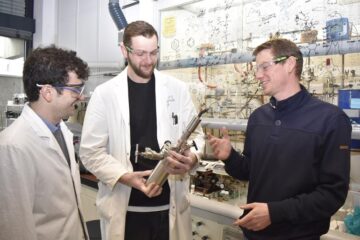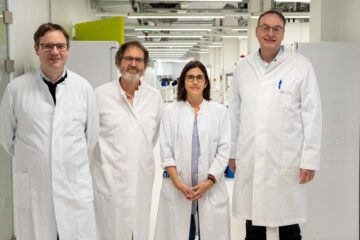‘Mini-Cellulose’ Molecule Unlocks Chemistry of Biofuel

Studying this ‘mini-cellulose’ molecule reveals for the first time the chemical reactions that take place in wood and prairie grasses during high-temperature conversion to biofuel. The new technical discovery was reported in the January 2012 issue of the journal Energy & Environmental Science and highlighted in Nature Chemistry.
The “mini-cellulose” molecule, called á-cyclodextrin, solves one of the major roadblocks confronting high-temperature biofuels processes such as pyrolysis or gasification. The complex chemical reactions that take place as wood is rapidly heated and breaks down to vapors are unknown. And current technology doesn’t allow the use of computer models to track the chemical reactions taking place, because the molecules in wood are too large and the reactions far too complicated.
Paul Dauenhauer, assistant professor of chemical engineering and leader of the UMass Amherst research team, says the breakthrough achieved by studying the smaller surrogate molecule opens up the possibility of using computer simulations to study biomass. He says, “We calculated that it would take about 10,000 years to simulate the chemical reactions in real cellulose. The same biofuel reactions with ‘mini-cellulose’ can be done in a month!”
Already his team has used insight from studying the “mini-cellulose” to make significant progress in understanding wood chemistry, Dauenhauer says. Using the faster computer simulations, they can track the conversion of wood all the way to the chemical vapor products. These reactions include creating furans, molecules that are important for the production of biofuels.
The discovered reactions occurring within wood will serve as the basis for designing advanced biofuel reactors, Dauenhauer says. By creating reaction models of wood conversion, the scientists can design biomass reactors to optimize the specific reactions that are ideal for production of biofuels. For biofuels production, “We want to maximize our new pathway to produce furans and minimize the formation of gases such as CO2,” says Dauenhauer.
The discovery of “mini-cellulose” was enabled by a new experimental technique for studying high-temperature biomass chemistry called “thin-film pyrolysis.” It involves creating sheets of cellulose, which makes up 60 percent of wood biomass, that are very thin, just a few microns thick. When the sheets are very rapidly heated at over one million degrees Celsius per minute, they create volatile chemicals which are the precursors of biofuel.
Dauenhauer joined the university in 2009 and conducts his research as part of the Catalysis Center for Energy Innovation in collaboration with the University of Delaware and funded by the U.S. Department of Energy (DOE). His research team includes Professor Dion Vlachos and graduate students Matt Mettler, Alex Paulsen and Samir Mushrif.
Dauenhauer has received several high-profile grants in the past year. In May 2011, he awarded a five-year, $800,000 Early Career Award in Basic Energy Sciences from the DOE. The grant provides support for his research on understanding the catalysts that control the process of breaking down plant matter into chemicals and fuel byproducts.
In February 2011, he was awarded a one-year, $80,000 grant from the National Science Foundation to conduct basic research on pyrolysis. Additionally in 2011, he was awarded a three-year Young Faculty Award from the 3M Corporation.
Media Contact
More Information:
http://www.umass.eduAll latest news from the category: Life Sciences and Chemistry
Articles and reports from the Life Sciences and chemistry area deal with applied and basic research into modern biology, chemistry and human medicine.
Valuable information can be found on a range of life sciences fields including bacteriology, biochemistry, bionics, bioinformatics, biophysics, biotechnology, genetics, geobotany, human biology, marine biology, microbiology, molecular biology, cellular biology, zoology, bioinorganic chemistry, microchemistry and environmental chemistry.
Newest articles

Efficient, sustainable and cost-effective hybrid energy storage system for modern power grids
EU project HyFlow: Over three years of research, the consortium of the EU project HyFlow has successfully developed a highly efficient, sustainable, and cost-effective hybrid energy storage system (HESS) that…

Safer alternative for an explosive reaction
The chemical industry has been using a reaction with explosive chemicals for over 100 years – now Mülheim scientists have discovered a safer alternative. The Ritter Group of the Max…

How immune cells communicate to fight viruses
Chemokines are signalling proteins that orchestrate the interaction of immune cells against pathogens and tumours. To understand this complex network, various techniques have been developed to identify chemokine-producing cells. However,…





















